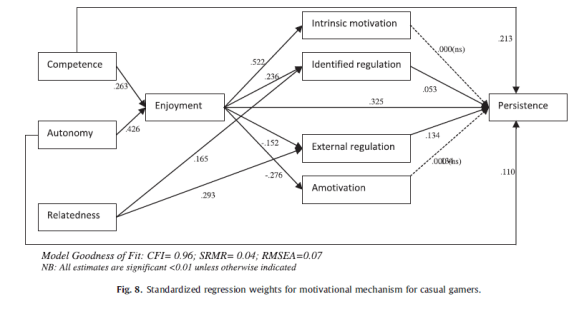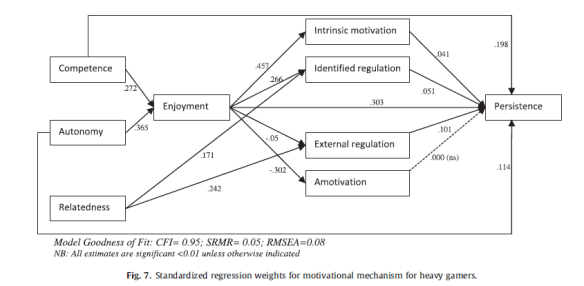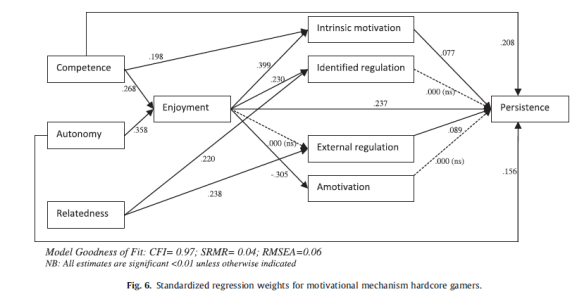Trending
Opinion: How will Project 2025 impact game developers?
The Heritage Foundation's manifesto for the possible next administration could do great harm to many, including large portions of the game development community.

Featured Blog | This community-written post highlights the best of what the game industry has to offer. Read more like it on the Game Developer Blogs or learn how to Submit Your Own Blog Post
A study examining into the role of self-determination and gamer identity on persistence in gaming

Here is a scene from the anime series Haikyū!!
Teams of hardcore volleyball players aim to be qualified in the national championship. Only one team is qualified and must struggle through other teams whose strengths frustrate their success. Nevertheless, they succeed through persistence. One more time, one point at a time. A less dedicated team would have given up far sooner and frustrated more easily.
Joyce Neys (Erasmus University Rotterdam), Jeroen Jansz (Erasmus University Rotterdam) and Ed Tan (University of Amsterdam) explored persistence among videogame players and how self-determination and one’s identification as a gamer may contribute to persisting in videogame sessions.
Abstract
The question of why players of video games persist gaming in the face of what seems to be insufficient reward has not yet been properly answered. This paper approaches the issue by combining two general psychological theories: Self-determination Theory (Deci & Ryan, 2000) and Social Identity Theory (Tajfel & Turner, 1986). A large scale survey (N = 7252) enabled a comparison of three groups which differed in terms of their Gamer Identity Strength (GIS), namely the degree to which players define gaming as part of their social identity. GIS is highest in Hardcore gamers and lower for Heavy and Casual gamers. GIS was positively, and uniformly, related with needs for Competence, Autonomy and Relatedness. Meanwhile, regulation was greater and more internal in the higher GIS groups. Finally, persistence was found to increase with GIS. The structure of needs and regulation modes underlying persistence was comparatively analyzed for the three groups; similarities between GIS groups were more frequent than differences. Most importantly, results indicated that Casual and Heavy gamers were motivated to continue to play as a result of both the feelings of enjoyment and a sense of connectedness. Hardcore gamers were more intrinsically motivated through enjoyment enhancing their levels of persistence accordingly.
Cross-posted at VG Researcher.
Many players, in one game or another, persistently attempt to beat the same level or scenario over and over. These repetitions can seem disturbing to outsiders and frustrating to players that they would quit, but some players persist. Based on previous studies, persistence can be derived from our gratifications and, in turn, our enjoyment we gain from playing videogames; in other words, we persist because we enjoy playing. However, recent development suggest that we enjoy to play videogames because they satisfy our psychological needs which in turn feed our persistence.
Persistence is often defined as a personality trait concerned with mastery, self-control and focused attention. The authors took a different perspective in that persistence manifest behaviourally; we play despite setbacks, frustration of achieving goals and insufficient rewards. Our behavioural persistence is an outcome of other motivational factors. The motivational factors are explained by the self-determination theory which posit that the satisfaction of three basic human needs determine our behaviours: autonomy, competence and relatedness. Furthermore, these behaviours are regulated at different levels from the highest form to the lowest: Intrinsic motivation where the activity is performed for its own sake; Identified regulation where the activity is performed for its own sake, but as a means to an end and regulated by external rewards; External regulation where the activity is regulated by external rewards; Amotivation where there are no motivation, no expectations of rewards or purpose. Thus, these levels of regulation set the tone of how we enjoy the activities, although not everyone is on the same level.
The regulation levels differ across players, some play for the thrill whereas some for the distraction. The authors propose that players’ social identity strength, in this case as a gamer, determine their persistence level. They persist based on how strongly they identify as a gamer and compare themselves to gamers’ behaviour in similar situations. Much like these volleyball players from Haikyū!!, they persist to win because they are volleyball players, not people who play volleyball. Similarly, the stronger a player identify as a gamer, the stronger the need to satisfy through gaming and this will become a stronger persistence.
Method
Participants: 7252 online respondents. The authors posted their online survey on IGN.com and I’m guessing in 2010. Average age is 20.55 (SD = 5.54), average play time per week is 18.09 (SD = 14.63), more than 95% of respondents are men.
Measures
Motivation needs: The Player Experience of Needs Satisfaction, an 11-item answered on a 7-point agreement scale. It assess for autonomy, competence and relatedness.
Regulation level: The Situational Motivational Scale, a 16-item answered on a 7-point agreement scale.
Gamer Identity strength: Respondents were asked to identify themselves either as the following: casual, heavy or hardcore. Respondents were asked to briefly explain their choice. Heavy and casual gamers cite their reasons through their time and money spent on gaming. Casual gamers cite gaming as just a leisure activity among they pursue in. Hardcore gamers, on the other, explicit cite being a gamer as their identity, they take gaming seriously, they organize significant parts of their daily life around gaming and they keep themselves informed on videogames. The authors noted that the gaming industry uses these terms as well.
In addition, they responded how many hours they spent playing videogames per week. This is validated by the statistical differences in the amount of time spent playing between the three identity groups: causal gamers play an average of 9.57 hours per week; heavy gamers play an average of 18.58 hours per week; hardcore gamers play an average of 26.22 hours per week.
Enjoyment: 4 items answered on a 7-point agreement scale. Example item: “I enjoy playing the game very much”.
Persistence: 2 items answered on a 7-point scale. The items are “Given the chance I will play this game in my free time” and “I want to finish the game no matter what”.
Results
The authors compared the groups’ motivations, regulation, enjoyment and persistent levels. They found that all three groups differ significantly in that hardcore gamers scored the highest on all three motivational needs, followed by heavy gamers and then casual gamers. All gamers scored high on intrinsic and identified motivation with hardcore scoring highest. Interestingly, casual gamers had higher amotivation scores than hardcore gamers. Hardcore gamers reported the highest enjoyment score (M= 6.32, SD .72), followed by heavy gamers (M= 6.1, SD = .69) and casual gamers (M= 5.8, SD=.78). Hardcore gamers scored highest on persistence (M=5.8, SD=1.12) followed by heavy gamers (M=5.39, SD=1.14) and casual gamers (4.95, SD=1.15).
The authors conducted structural equation models for the three gamer groups and the models revealed interactions between the variables.

Model for casual players

model for heavy players

Model for hardcore players
In general, enjoyment is predicted by satisfying competence and autonomy needs. Relatedness do not contribute to enjoyment, but contribute to both identified and external regulation. Enjoyment contribute to all levels of regulation and in different directions. Positive directions for all three, except for amotivational as predicted. Persistence is predicted by enjoyment and, both directly and indirectly, by competence and autonomy needs. The regulation levels contribution to persistence is relatively small.
The effect sizes and directions in the model differ between the groups. For casual gamers, autonomy has the greatest effect on enjoyment among the three group. Similarly, enjoyment has the greatest effect on persistence. For hardcore gamers, competence has the greatest total effect to persistence directly and indirectly through enjoyment and intrinsic motivation. Nevertheless, the differences in effect sizes and directions between the three groups are rather small.
Discussion
The take home message is that a player’s social identity strength affect how much they enjoy and persist in gaming. The higher one identifies as a gamer, the greater their enjoyment (and perhaps more excitable), the more persistent in gaming. The underlying process which players enjoy and persist in gaming are quite similar. The satisfaction of human needs through gaming affect enjoyment and, directly and through enjoyment, persistence in gaming. There are differences between identity groups in how enjoyment and persistence are affected. Hardcore gamers were more intrinsically motivated to persist than heavy and causal gamers whereas the latter persist their gaming through the feelings of enjoyment and relatedness.
The authors argued two factors involved in gamer identity strength’s (i.e. hardcore, heavy and causal) affect on need satisfactions, the first factor is players’ experiences with videogames. Players who spent more time on videogames are more experienced through repeated practice. Similarly, how our volleyball players derive much of their excitement through their frequent practices. The second factor is a history of success. They argued that successes in gaming increases players’ self-awareness of their gaming prowess. This self-awareness would help develop their identity as a gamer and encourages them to pursue greater challenges and further enhancing their need satisfaction through gaming. Hence, positive experiences in gaming further integrate their gamer identity into their self-concept. This integration leads more gaming experiences as more intrinsic than a causal gamer would experience. The results supported the idea that hardcore gamers are highly intrinsically motivated. Perhaps players should not judge other players on their gaming knowledge or taste; they should respect them by their passion and intrinsic enjoyment from gaming, even if it’s a casual game like Candy Crush Saga derided by hardcore gamers. You might find that hardcore Candy Crush player persist with the same drive and enjoyment on a different videogame.
The authors offered words of caution about the limitations of their study. Their sample consisted of people from a gaming website which affects representativeness, although it is no less different than other videogame survey studies. In other words, no gaming lab has the resources for a representative sample of gamers. Their casual gamers may have once been hardcore gamers, since identities are rather fluid over time. They suggest including players who hardly play videogames. Their assessment for persistence consisted of two items which is simple and suggested a more complex and refined assessment.
References
Neys, J. L. D., Jansz, J., & Tan, E. S. H. (2014). Exploring persistence in gaming: The role of self-determination and social identity. Computers in Human Behavior, 37 , 196-209.DOI:10.1016/j.chb.2014.04.047
Read more about:
Featured BlogsYou May Also Like